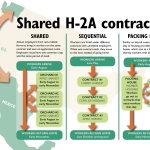Small growers who can’t justify the high costs of employing foreign guest workers through the H-2A program can reduce the financial burden by sharing workers with other growers.
Growers employing H-2A workers must pay all attorney or agent fees, application fees, and other recruitment costs.
They must provide workers with free transportation and a daily subsistence amount for the return trip between Mexico and the orchard.
They must provide workers with free housing and free cooking facilities, or three meals a day costing the workers no more than a specified amount, and free transportation between the housing and the worksite.
Growers must also pay the workers the highest of the following rates: the adverse effect wage rate (which in Washington State is set at $12.42 per hour this year), the applicable prevailing wage, or the state or federal minimum wage. Piece-rate wages are also fixed. Domestic workers doing equivalent work must be paid at the same rates during the H-2A contract period.
Shared contract: A shared contract can work for growers who need workers for the same period and have one crop in common. This allows employers to bring in a larger number of workers on a single contract and save application costs, according to the Washington Farm Labor Association.
For example, four growers in Yakima could hire a group of workers from August until November for apple harvest. Workers could work at any of the orchards during that period as needed.
Sequential contracts: Growers who need workers for short, but different periods of time can use sequential contracts. Employees work for each of the growers in succession.
For example, workers might arrive to pick vegetables for the first grower in March, then transfer to the second grower to pick cherries from late May to July. A third grower might need them to detassel corn in mid summer, and a fourth grower might employ them in late August through the end of apple harvest.
Packing house contract: A third type of contract allows a packing house to facilitate the H-2A process for its growers.
Workers stay at the same housing for the whole contract period, and the packing house acts as a liaison for sharing workers among growers listed in the contract. Workers go out to whichever orchards need them each day.
Sam Godwin of Tonasket had a shared contract last year with his parents who also have orchards. Workers were able to move between the orchards as needed.
Mark Stennes, a grower at Pateros in north central Washington, employed workers through a sequential contract last year. The workers were employed first at a farm in Washington’s Columbia Basin. In late July, they moved to the Stennes orchard, where they worked during pear and apple harvests.
Under the sequential contract model, each grower has a separate contract and has to pay all the costs while the workers are on their farm, but it halved the costs relating to recruitment and transportation, which amount to about $1,300 per worker, Stennes said. “It worked out great.”







Leave A Comment